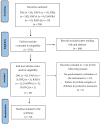A Systematic Review on Assessing Assessments: Unveiling Psychometric Properties of Instruments for Reactive Attachment Disorder and Disinhibited Social Engagement Disorder in Minors under Protective Measures
- PMID: 38397256
- PMCID: PMC10887385
- DOI: 10.3390/children11020144
A Systematic Review on Assessing Assessments: Unveiling Psychometric Properties of Instruments for Reactive Attachment Disorder and Disinhibited Social Engagement Disorder in Minors under Protective Measures
Abstract
Background: Reactive attachment disorder (RAD) and disinhibited social engagement disorder (DSED) manifest in individuals facing attachment system challenges, particularly observed in minors under protective measures. The lack of standardized tools for assessing these difficulties and uncertainty about the most effective instruments from a psychometric perspective prompted this study.
Aim: Using the COSMIN checklist, we systematically reviewed instruments assessing RAD, adhering to PRISMA.
Methodology: Examined tools included the Disturbance Attachment Interview, Preschool Age Psychiatric Assessment, Relationship Patterns Questionnaire, Assessment of RAD and DSED, Development and Well-Being Assessment, and Reactive Attachment Disorder Questionnaire.
Results: Of the 10 articles analyzed, the results highlight a research emphasis on internal consistency and structural and construct validity, sidelining other properties.
Conclusion: Most articles review structural validity and internal consistency. These measures are satisfactory but insufficiently evaluated. It is necessary to evaluate these tools using other indicators such as cross-cultural validity, measurement error, or responsiveness in adolescents under protective measures.
Keywords: COSMIN; adolescents; children; psychometric proprieties; reactive attachment disorder; systematic review.
Conflict of interest statement
The authors declare no conflicts of interest.
Figures
Similar articles
-
Validity of reactive attachment disorder and disinhibited social engagement disorder in adolescence.Eur Child Adolesc Psychiatry. 2020 Oct;29(10):1465-1476. doi: 10.1007/s00787-019-01456-9. Epub 2019 Dec 12. Eur Child Adolesc Psychiatry. 2020. PMID: 31832788 Free PMC article.
-
Reactive attachment disorder and disinhibited social engagement disorder in adolescence: co-occurring psychopathology and psychosocial problems.Eur Child Adolesc Psychiatry. 2022 Jan;31(1):85-98. doi: 10.1007/s00787-020-01673-7. Epub 2020 Nov 13. Eur Child Adolesc Psychiatry. 2022. PMID: 33185772 Free PMC article.
-
Reactive Attachment Disorder and Disinhibited Social Engagement Disorder in School-Aged Foster Children--A Confirmatory Approach to Dimensional Measures.J Abnorm Child Psychol. 2016 Apr;44(3):445-57. doi: 10.1007/s10802-015-0045-4. J Abnorm Child Psychol. 2016. PMID: 26126635 Free PMC article.
-
Development and Validation of a Measure of Attachment Disorders Based on DSM-5 Criteria: The Early TRAuma-Related Disorders Questionnaire (ETRADQ).Assessment. 2022 Apr;29(3):556-571. doi: 10.1177/1073191120981763. Epub 2020 Dec 31. Assessment. 2022. PMID: 33380162 Review.
-
Reactive Attachment Disorder and Its Relationship to Psychopathology: A Systematic Review.Children (Basel). 2023 Dec 6;10(12):1892. doi: 10.3390/children10121892. Children (Basel). 2023. PMID: 38136094 Free PMC article. Review.
References
-
- American Psychiatric Association . Diagnostic and Statistical Manual of Mental Disorders, Third Edition (DSM-III) American Psychiatric Association; Washington, DC, USA: 1980.
-
- American Psychiatric Association . Diagnostic and Statistical Manual of Mental Disorders (5-TR ed.) American Psychiatric Association; Washington, DC, USA: 2022.
-
- Ellis E.E., Yilanli M., Saadabadi A. StatPearls. StatPearls Publishing; St. Petersburg, FL, USA: 2023. Reactive Attachment Disorder. - PubMed
Publication types
LinkOut - more resources
Full Text Sources


